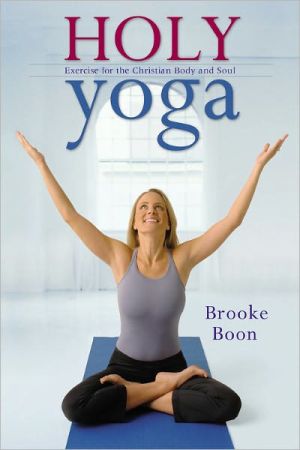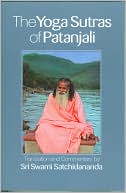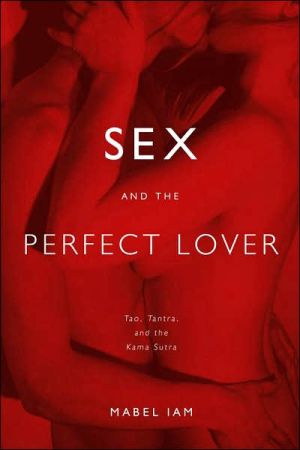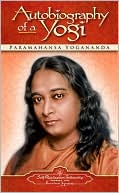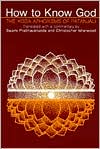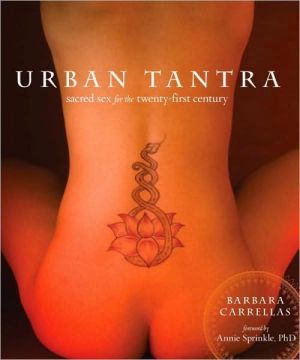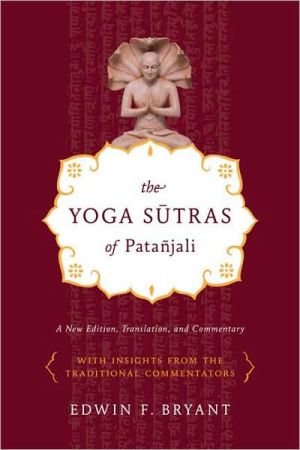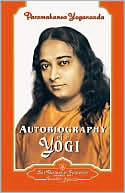Holy Yoga: Exercise for the Christian Body and Soul
People often equate yoga with\ Eastern religion, but Brooke Boon\ sees it as an exercise style that\ Christians can use to generate patience,\ strength, and deeper worship.\ Author and yoga instructor\ Brooke Boon combines her passion\ for Christianity with her commitment\ to health to introduce yoga as\ a physical and spiritual discipline\ that strengthens the body and the\ soul. Clear explanations and photographs\ make yoga accessible for\ any reader, and Brooke offers customized\ routines...
Search in google:
People often equate yoga withEastern religion, but Brooke Boonsees it as an exercise style thatChristians can use to generate patience,strength, and deeper worship.Author and yoga instructorBrooke Boon combines her passionfor Christianity with her commitmentto health to introduce yoga asa physical and spiritual disciplinethat strengthens the body and thesoul. Clear explanations and photographsmake yoga accessible forany reader, and Brooke offers customizedroutines for readers strugglingwith specific issues, such asweight loss and anxiety. Through it all Brooke uses scripturalreferences to help reinforce the idea that by takingcare of our bodies we can also take care of our faith.
Holy Yoga\ Exercise for the Christian Body and Soul \ \ By Brooke Boon \ Faithwords\ Holy Yoga Living, LLC\ All right reserved.\ ISBN: 978-0-446-69915-0 \ \ \ Chapter One\ Understanding Yoga \ May the God who gives endurance and encouragement give you a spirit of unity among yourselves as you follow Christ Jesus. Romans 15:5\ When I first began to practice yoga, I was attending secular yoga classes that incorporated aspects of Eastern or New Age thought. My teachers routinely encouraged their students to "look within" to find their divinity. They whispered promptings for us to seek enlightenment through oneness with the universe. They taught that everything we need is all inside of us-we just have to find it.\ I guess it was intended to be a comforting and hopeful message. But when I was told it was "all about me," I wasn't comforted at all. Frankly, it scared me to death. I hadn't met Christ yet but I was searching, and I knew that whatever I needed, it wasn't inside of me. My train wreck of a life had given me clear evidence of that! I would go to those classes and practice the postures, all the while thinking that if it was really all about me, then I had a serious problem. I didn't know much, but one thing was clear: I could not continue to do life all by myself.\ When I became a Christian and began learning how to use yoga in my spiritual walk with Jesus, it was such arelief! How comforting to know that living life in peace and joy doesn't depend on me. Thank You, Jesus, for being my Savior, thank You that it's not all up to me!\ I went into those secular classes unaware of the history, traditions, philosophies, and spiritual aspects of yoga. Like many Western practitioners of yoga today, I just wanted to get into shape! Being ignorant made me vulnerable to an Eastern spiritual influence, but praise God, it never became something that interested me. It actually never felt right to me. Once I was reborn in Jesus Christ, I finally knew why.\ You don't need to know the entire history of yoga to understand what it is and how it can help you. I certainly don't want to bore you with a long history lesson. You can walk into a gym or yoga studio any day of the week and begin practicing yoga right away as I did, without knowing a thing. But there are certain things about yoga that are fascinating, and knowing them will help your practice and your motivation. There are also a few misunderstandings about yoga that we'll need to clear up, so that you're not going into this endeavor with false assumptions. Most importantly, there are distinctions that we'll need to make between Holy Yoga and all other styles.\ First, let's get to know the basics about yoga.\ What Is Yoga?\ The whole system of yoga is built on three main structures: physical postures, breathing, and meditation. The postures (or poses) in yoga are designed to put pressure on the glandular systems of the body, thereby increasing the body's efficiency and total health. The muscles are alternately stretched and contracted, and spaces are made in the joints to increase elasticity and range of motion. Yoga looks upon the body as the primary instrument that enables us to work and evolve in the world, and so a yoga student treats it with great care and respect.\ Breathing techniques are based on the concept that breath is the source of life in the body. The yoga student gently increases breath control to improve the health and function of both body and mind. These two systems of poses and breathing then prepare the body and mind for meditation, and the student finds an easy approach to a quiet mind that allows silence and healing from everyday stress. Regular daily practice of all three parts of this structure of yoga produce a clear, bright mind and a strong, capable body.\ No one knows exactly when yoga began, but it certainly predates written history. Stone carvings depicting figures in yoga positions have been found in archeological sites in the Indus Valley dating back five thousand years or more. There is a common misconception that yoga is rooted in Hinduism; on the contrary, Hinduism's religious structures evolved much later and incorporated some of the physical practices of yoga. Other religions throughout the world have also incorporated physical practices and ideas related to yoga.\ The tradition of yoga has always been passed on individually from teacher to student through oral instruction and practical demonstration. The formal techniques that are now known as yoga are, therefore, based on the collective experiences of many individuals over centuries. The particular manner in which the techniques are taught and practiced today depends on the approach passed down in the line of teachers supporting the individual practitioner.\ The word yoga comes from an ancient Sanskrit word meaning "unity" or "to join." It also connotes discipline or effort. Yoga is about using discipline and effort toward the goal of unity.\ Scripture has much to say about unity! Jesus prayed for His disciples and all believers that we would be unified in each other and in Him (John 17:20-24). The apostle Paul urged us repeatedly to be unified in the body of Christ. In Colossians 3:14, Paul reminded us that love is the virtue that "binds them all together in perfect unity."\ But is the unity of yoga the same as the unity we pursue as Christians? Traditionally, yoga is the discipline of unifying the body, mind, and spirit. In Holy Yoga, we pursue unity of body, mind, and His Holy Spirit that dwells within us, with the intent of worshiping and serving Christ with our entire beings.\ Many of us walk around in a fragmented state, whether or not we realize it. We experience our emotions separate from our thoughts; we experience our bodies as distinct from our minds; we disconnect our spiritual lives from everything else, relating to God only on Sunday mornings or in dedicated times of prayer. In truth, all this compartmentalization is a false way of living. We are integrated beings: our thoughts, feelings, bodily experiences, and spiritual longings are all a part of who we are and are not meant to be experienced as separate.\ In order to worship God fully and to experience the lives He has set out for us, we need to be our most authentic, real, whole selves. Holy Yoga is a means to unifying ourselves so that we can open up fully to God's grace and love. Think about how this might play out in your life. You may be mentally willing and seeking the Lord, but your emotions are a mess. Or perhaps you are seeking God with your heart, but your mind can't seem to grasp the reality. You might be desiring closeness with the Lord, but your body is betraying you in some way, through pain or illness, and it causes you to falter on your spiritual path. All these schisms between mind, body, and spirit prevent us from experiencing the fullness of God, which then diminishes our ability to worship Him completely.\ As we work to unify our bodies, minds, and spirits with the Lord, we also naturally open up to more genuine union with others around us. This leads directly to one of the goals of our Christian lives: to be "one in the Spirit," or unified in the body of Christ. I like the way Paul put it in his letter to the Ephesians: "Make every effort to keep the unity of the Spirit through the bond of peace. There is one body and one Spirit-just as you were called to one hope when you were called-one Lord, one faith, one baptism; one God and Father of all, who is over all and through all and in all" (4:3-6). The idea of unity is a beautiful, biblical picture of God's perfect desire for His people.\ Classical Yoga Theories\ A scholar named Patanjali compiled one of the earliest texts having to do with yoga. He set down the most prevalent yoga theories and practices of his time in a book he called Yoga Sutras, translated "Yoga Aphorisms" (an aphorism is a concise statement of a principle). Patanjali wrote somewhere between the first century BC and the fifth century AD. The system he wrote about is generally referred to today as Classical Yoga.\ The eight steps of Classical Yoga are:\ 1) restraint-refraining from violence, lying, stealing, casual sex, and hoarding.\ 2) observance-purity, contentment, tolerance, study, and remembrance.\ 3) physical exercises.\ 4) breathing techniques.\ 5) preparation for meditation.\ 6) concentration-being able to hold the mind on one object for a specified time.\ 7) meditation-the ability to focus on one thing (or nothing) indefinitely.\ 8) absorption-the realization of the essential nature of the self.\ Yoga probably arrived in the United States in the late 1800s, but it did not become widely known until the 1960s. As more became known about the beneficial effects of yoga, it gained acceptance and respect as a valuable method for helping in the management of stress and improving health and well-being. Many physicians now recommend yoga practice to patients at risk for heart disease, as well as those with back pain, arthritis, depression, and other chronic conditions. (Always check with your doctor before beginning any exercise program.)\ Yoga is a system of techniques that can be used for a number of goals, from simply managing stress better, learning to relax, and increasing flexibility all the way to becoming more self-aware and acquiring the deepest knowledge of one's own self in Christ. I have developed Holy Yoga specifically for the purpose of increasing health-mind, body, and spirit-while consciously seeking a deeper relationship with the Lord Jesus Christ.\ The type of yoga most of us are familiar with involves stretching our bodies into various postures. This is the physical element and is known as Hatha Yoga. Hatha Yoga also incorporates mindful breathing, relaxation, and meditation. It is the yoga of physical dis-cipline. Holy Yoga is also based on Bhakti Yoga, the yoga of devotion. Its goal is to connect or even merge with a supreme being through acts of devotion. Our Bhakti Yoga is all about getting in touch with the Holy Spirit by following the outpourings of our hearts, although we certainly don't have "merging with" the Holy Spirit as our goal, since we know that's impossible as well as a heretical idea. The term bhakti can be roughly translated to mean "devotion," and this, coupled with the Christian concept of faith, leads to a state of mind that can be described as being immersed in the Holy Spirit. This strand of yoga principally advocates love and devotion.\ Our use of the postures of Hatha Yoga together with the spiritual intent-although thoroughly Christian-of Bhakti Yoga are what make our practice of yoga truly holy.\ Yoga as a Philosophy\ Yoga can be thought of as a philosophy. It's the idea that by bringing a union of focus between mind and body, while simultaneously making the mind and body stronger and more flexible, we become more authentic people, able to hear God and experience Him in previously impossible ways. While other religions have used this philosophy to meet their own requirements, such as looking for God inside oneself or seeking oneness with the environment, the Holy Yoga approach is to seek Christ only. We were created to have a relationship with our heavenly Father, so the focus is on Christ, the goal is Christ, and the result is a deeper relationship with and experience of Him.\ The central doctrine of ancient, traditional yoga philosophy is that nothing exists beyond the mind and its consciousness, which is the only ultimate reality. As practitioners of Holy Yoga, we recognize this original idea but reject it in favor of biblical truth. Ancient yoga's goal was to bring participants to the "ultimate truth." Our goal in Holy Yoga is the same-it's just that we have a different definition of "truth." We know that Jesus is "the way and the truth and the life" and that no one gets to the Father except through Him (John 14:6). We seek only the truth of Jesus Christ.\ Yoga as Art and Science\ Besides being a philosophy, yoga is also a little bit science and a little bit art. The science behind it confirms that the practice of stretching the body-opening up spaces in joints, loosening muscles, and purposefully relaxing-is a major benefit to good health. There are so many physical benefits that for some people, yoga's effects seem nothing short of miraculous. Perhaps yoga's primary advantage in our busy lives today is its effectiveness in stress management. Chapter 6 explores in detail the proven health benefits.\ The art of yoga comes in the numerous, individualized ways we practice. There are specific postures, techniques, and attitudes that are part of the package. But we all practice in our own ways, according to our unique bodies, minds, and spiritual experiences. It is an art much like dancing. While the steps may be choreographed, it is the individual dancer who breathes life into the form, making it a beautiful expression full of feeling and depth. Practicing yoga can be quite fulfilling for the "artist" in each of us.\ Holy Yoga embraces the physical, mental, emotional, and spiritual realms, with the focus always on opening up to God and connecting with Him. Holy Yoga is all about Jesus and learning to depend on Him more and more fully as our spiritual growth progresses.\ Styles of American Yoga\ Yoga has been practiced in the West for only about the last century. Since Americans began embracing yoga, several new "styles" or brands of yoga have been developed by various teachers to better meet the needs of Westerners.\ It can be confusing if you look in the phone book or drive down the street and see names like "Ashtanga Yoga" or "Bikram Yoga" or "Kripalu Yoga." The names are simply telling you what style that studio teaches. One style may focus more on bodily alignment, while another focuses on athletic "power"-type moves. Some styles emphasize the individual's needs and capacity, while others encourage precise implementation of each posture regardless of unique body types.\ Each style was originated by a particular yoga teacher and has been carried on by other teachers and students over time. Since there are hundreds of books, articles, and Web sites available to explain the various styles of yoga, I'm not going to describe them in detail, but feel free to consult other sources if you would like to learn more.\ All these styles of yoga involve the traditional yoga postures that teachers have been passing down through generations for thousands of years. The postures themselves are similar no matter where you go-anywhere in the world! But the sequence of postures, the manner in which they're undertaken, and the mental/spiritual intent vary. How does Holy Yoga fit into this picture? Holy Yoga has been developed to be yet another unique "style" of yoga. We use the same basic body positions as in all of yoga. But we use them in conjunction with specific language to help accentuate the physical pose and to worship God, connect with Christ, and be filled with the Spirit.\ The idea of Christian yoga isn't brand-new. Thomas Ryan, a Catholic priest and scholar, has studied yoga in depth for many years. His 1995 book, Prayer of Heart and Body, was an important work establishing yoga as legitimate Christian discipline. His more recent work, Reclaiming the Body in Christian Spirituality, takes the idea further by examining the role of the body in Christian spiritual life. He encourages a healthy spiritual attitude toward our bodies and shows us how our physical activities are acts of worship toward our Creator, God.\ More recently, Episcopal priest Nancy Roth has been studying and teaching yoga and has authored a wonderful little book, An Invitation to Christian Yoga. Some of her teachings, though seemingly simple, have been life-changing for me as I came to understand the profound spirituality inherent in the movement of the body in union with the mind and spirit.\ Why Is Yoga So Popular?\ Larry Payne, coauthor of Yoga for Dummies and Yoga Rx, calls yoga a "natural, do-it-yourself prescription for good health and stress management." Sounds great, doesn't it? I think that definition embodies the reason for the popularity of yoga.\ Today we know that stress is one of the greatest contributors to poor health. Stress makes a healthy body more open to disease and worsens the effects of most illnesses and ailments. On top of all that, being stressed just doesn't feel good! Yoga is one of the best ways to calm a stressed mind and body.\ (Continues...)\ \ \ \ \ Excerpted from Holy Yoga by Brooke Boon Excerpted by permission.\ All rights reserved. No part of this excerpt may be reproduced or reprinted without permission in writing from the publisher.\ Excerpts are provided by Dial-A-Book Inc. solely for the personal use of visitors to this web site. \ \
